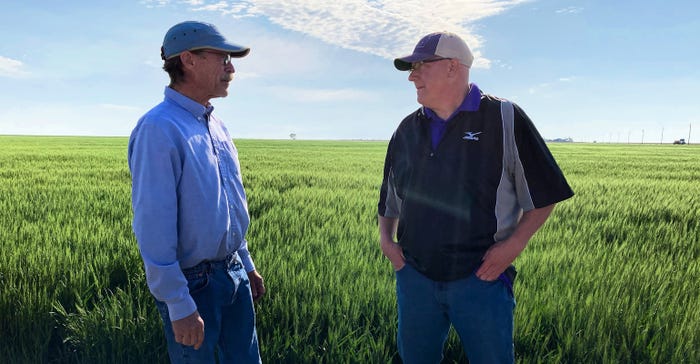
It’s too late for the wheat crop on the Millershaski farm, north of Lakin, Kan., in Kearny County.
It’s May 18, and Kyler Millershaski stands in a field of Joe, a hard white wheat variety, that should be close to waist-high, and lush and green. Instead, this wheat reaches just barely above his calf. The stand is thin, with low tillers, and every step he takes farther into the field creates a tiny puff of dust.
We just didn’t get the rain, he says.
This field, even as thin as it is, will likely go to harvest. At $13 per bushel, every bushel harvested counts. But other Millershaski fields that are not so lucky will be zeroed out by crop insurance adjusters and grazed. If you think it’s dry in the wheat field, you should see the pastures in the area. Cattle producers are scrambling for forage for their herds, and even grazing wheat that’s headed out and thin is something for hungry herds.

At this point, any rain that falls is protecting what yield is already there, and just might be enough to plant corn or sorghum.
Hit and miss
The second day of the Wheat Quality Council’s annual Hard Winter Wheat Tour took participants on routes traveling south from Colby, Kan., to as far as just into Oklahoma, and then heading west across the southern half of the state, ending in Wichita, Kan.
Logan and Wichita counties, just south of Colby, saw lusher fields — mostly because of timely winter snowfall that held a lot of moisture.
Stewart Whitham, a farmer in Wichita County, just outside of Leoti, Kan., stands in one of those waist-high fields. This field of Joe, the same white wheat variety that Millershaski is growing one county south, was planted into fallow ground and was one of the lucky fields that caught those wet snowfalls. Whitham eyeballs the field and guesses it’ll make 65 bushels per acre.
The tour car calculates it at 66 bushels per acre using the USDA National Agricultural Statistics Service table.
Across the road, though, Whitham points to a neighbor’s field of wheat that was planted right after corn harvest into stubble. Planting wheat right after corn is a risk farmers take in that area — and if there’s enough moisture, it can work. This year, though, that corn took up most of the subsoil moisture before the wheat could get to it.
The tour car calculates it at 7 bushels per acre.
This is what the experts mean by a “spotty” wheat crop.
Quality
Romulo Lollato, Kansas State University Extension wheat and forage specialist, says he expected the wheat to start looking a little better when the tour headed east. But even as far as into Pratt and Kingman counties, tour cars saw drought-stressed wheat.

Right now, he explains, the earlier the heat stress happens in the crop’s development, the more damage it will sustain. The wheat crop has already determined its yield — the kernels are there in the head. The crop is now in the process of depositing the protein in the grain, translocating the nitrogen from the plant into the grain. Starch production, or grain fill, relies on energy created by the flag leaf and the canopy. So, heat stress later in the wheat’s life will cut down starch deposit, which is where we get test weight and yield.
If there’s a bright spot, it’s that the protein is already in the grain, and millers and bakers may have high-protein wheat coming out of the state this year. But there might not be much of it.
Day 2 numbers
The cars have all reached the hotel in Wichita, and the numbers are tallied for Day 2. Out of 254 stops for the day, the average yield is 37 bushels per acre. That’s 20 bushels per acre lower than the Day 2 tally last year.
Chris Kirby, with the Oklahoma Wheat Commission, says that of the 4.4 million acres planted to wheat this year, they’re expecting to abandon a large portion of their crop to drought.
If you farm west of I-35 it’s drought, drought, drought, she says. USDA estimates the state may have a crop of 57 million bushels. That’s half of what the state produced last year.
The combines in the southern part of Oklahoma are already rolling. And with temperatures above 100 degrees F and high winds on the forecast, Kirby says she expects harvest to proceed fast across the state.
Hope
Wheat farmers are just hoping they can hold on until harvest starts in a few weeks in Kansas.
It’s the evening of May 18, and the TV weather map finally shows rain moving east across the western half of the state. Some of that may just fall on the Millershaski farm.
It’s too late to make a big difference for his wheat, but Millershaski may be able to get corn in the ground and off to a start.
There’s always hope.
About the Author(s)
You May Also Like






